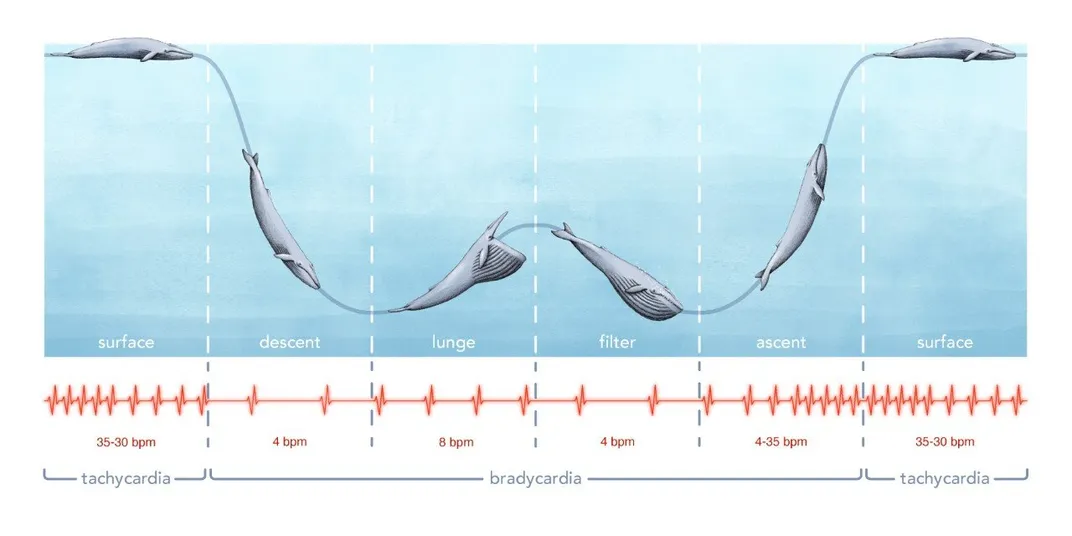Researchers Measure a Wild Blue Whale’s Heart Rate for the First Time
The team found the world’s largest mammal pushes its heart to its limits
/https://tf-cmsv2-smithsonianmag-media.s3.amazonaws.com/filer/cf/1b/cf1bb720-c514-48be-afa9-43986c4092d3/tagging_whale.jpg)
Scientists recently recorded the heart rate of a wild blue whale for the first time, finding that sometimes the world's largest mammal’s ticker beats only twice per minute.
A decade ago, members of the research team placed trackers on emperor penguins at McMurdo Station in Antarctica, monitoring their heart-rates as the birds dove in the icy waters of the Southern Ocean. That got them wondering whether they could use the same technology on blue whales, which can reach 110 feet and can dive as deep as 1,600 feet.
Recording the whale’s heart, however, was much tougher than dealing with penguins. According to a press release, to monitor the whale’s heart, the team needed to attach a sensor tag using four suction cups, two of which had electrodes in them that could monitor the animal’s heart. But blue whales have accordion-like skin that stretches and could pop the suction cup tag right off. Also, unlike captive whales, which the sensor was tested on, wild blue whales don’t turn belly up, especially in the presence of humans, meaning the team had to place the sensor and then hope it slid into a spot near the fin where it could collect data.
“I honestly thought it was a long shot because we had to get so many things right: finding a blue whale, getting the tag in just the right location on the whale, good contact with the whale's skin and, of course, making sure the tag is working and recording data,” says Stanford marine ecologist Jeremy Goldbogen, lead author of the paper, in a statement.
When the team located a pod of blue whales near Monterey Bay in California, co-author David Cade, who works in Goldbogen’s lab, got the tag to stick on his first attempt, attaching it to a 15-year-old male whale using a 20-foot pole. Eventually the lunchbox-sized data collector slid into place near the whale’s flipper and began monitoring its heart. The results appear in the journal Proceedings of the National Academy of Sciences.
Brandon Specktor at Live Science reports that the sensor stayed attached to the whale for 8.5 hours while the whale dove and surfaced dozens of times looking for krill. Once it fell off, the tag floated to the surface of Monterey Bay where the team collected it. The data shows the whale’s longest dive lasted 16 and a half minutes and reached a depth of 600 feet. The giant animal never spent longer than four minutes at the surface catching its breath.
The data also showed that at the lowest point of its dive, the whale’s heartbeat would slow to an average of four to eight beats per minute, and sometimes dipped as low as two beats per minute. When it began lunging and feeding underwater, its heart rate would increase. When it surfaced, the heartbeat ramped up to 25 to 37 beats per minute as it took in fresh oxygen.

The results were surprising. According to the press release, the whale’s lowest heart rate was 30 to 50 percent lower than predicted. The team suspects that the animal’s stretchy aortic arch, part of the main artery entering the heart, continues to slowly contract between heartbeats, maintaining blood flow to the animal’s body. The whale’s maximum heart rate was also higher than the researchers predicted.
The team suggests the whale’s heart is working at its physiological limit in the normal course of feeding, and perhaps that explains why the massive animals have not evolved to become even bigger.
“This blue whale had heart rates ranging from 2 bpm to 37 bpm, which is more than an order of magnitude difference — 10-fold,” Goldbogen tells Claire Cameron at Inverse. “In comparison, human heart rates might typically range from 60 bpm to 200 bpm, which is a much lower range, just over a 3-fold difference.”
The heart rate profile shows that the whales have likely maxed out on size. “Given that the heart rates appear to be maximal during routine diving behavior, even larger whales might have trouble meeting physiological demands,” says Goldbogen. “Much more research needs to be done to explore the many possible explanations for why we currently do not see any animal that is larger than a blue whale.”
The study not only adds to what we know about the blue whale’s basic biology, it may aid in its conservation.
“Animals that are operating at physiological extremes can help us understand biological limits to size,” Goldbogen says in the release. “They may also be particularly susceptible to changes in their environment that could affect their food supply. Therefore, these studies may have important implications for the conservation and management of endangered species like blue whales.”
The team now hopes to add an accelerometer to their sensor so they can understand how different activities affect the blue whale’s heart rate. They also want to attach the same type of sensors to other whales in the same family, including fin, humpback and minke whales.